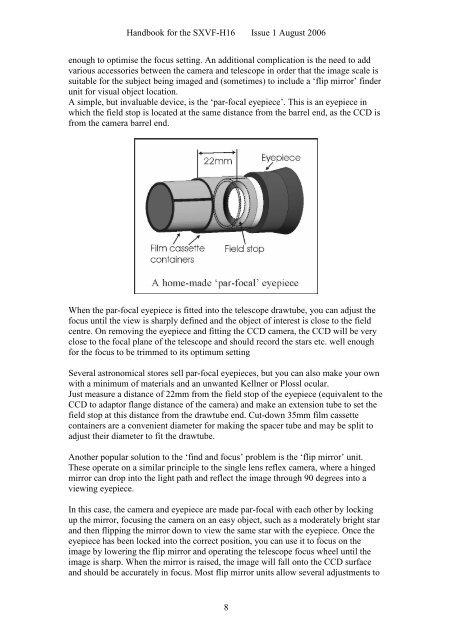SXVF-H16 handbook.pdf - Starlight Xpress
SXVF-H16 handbook.pdf - Starlight Xpress
SXVF-H16 handbook.pdf - Starlight Xpress
You also want an ePaper? Increase the reach of your titles
YUMPU automatically turns print PDFs into web optimized ePapers that Google loves.
Handbook for the <strong>SXVF</strong>-<strong>H16</strong> Issue 1 August 2006<br />
enough to optimise the focus setting. An additional complication is the need to add<br />
various accessories between the camera and telescope in order that the image scale is<br />
suitable for the subject being imaged and (sometimes) to include a ‘flip mirror’ finder<br />
unit for visual object location.<br />
A simple, but invaluable device, is the ‘par-focal eyepiece’. This is an eyepiece in<br />
which the field stop is located at the same distance from the barrel end, as the CCD is<br />
from the camera barrel end.<br />
When the par-focal eyepiece is fitted into the telescope drawtube, you can adjust the<br />
focus until the view is sharply defined and the object of interest is close to the field<br />
centre. On removing the eyepiece and fitting the CCD camera, the CCD will be very<br />
close to the focal plane of the telescope and should record the stars etc. well enough<br />
for the focus to be trimmed to its optimum setting<br />
Several astronomical stores sell par-focal eyepieces, but you can also make your own<br />
with a minimum of materials and an unwanted Kellner or Plossl ocular.<br />
Just measure a distance of 22mm from the field stop of the eyepiece (equivalent to the<br />
CCD to adaptor flange distance of the camera) and make an extension tube to set the<br />
field stop at this distance from the drawtube end. Cut-down 35mm film cassette<br />
containers are a convenient diameter for making the spacer tube and may be split to<br />
adjust their diameter to fit the drawtube.<br />
Another popular solution to the ‘find and focus’ problem is the ‘flip mirror’ unit.<br />
These operate on a similar principle to the single lens reflex camera, where a hinged<br />
mirror can drop into the light path and reflect the image through 90 degrees into a<br />
viewing eyepiece.<br />
In this case, the camera and eyepiece are made par-focal with each other by locking<br />
up the mirror, focusing the camera on an easy object, such as a moderately bright star<br />
and then flipping the mirror down to view the same star with the eyepiece. Once the<br />
eyepiece has been locked into the correct position, you can use it to focus on the<br />
image by lowering the flip mirror and operating the telescope focus wheel until the<br />
image is sharp. When the mirror is raised, the image will fall onto the CCD surface<br />
and should be accurately in focus. Most flip mirror units allow several adjustments to<br />
8
















